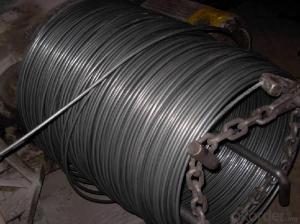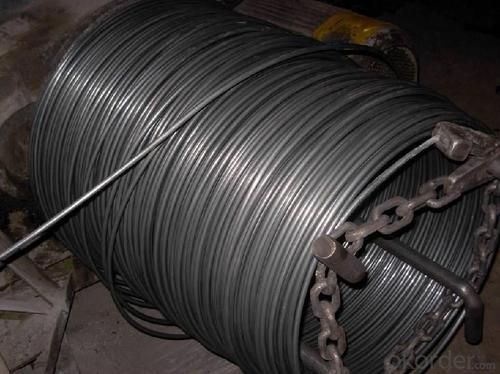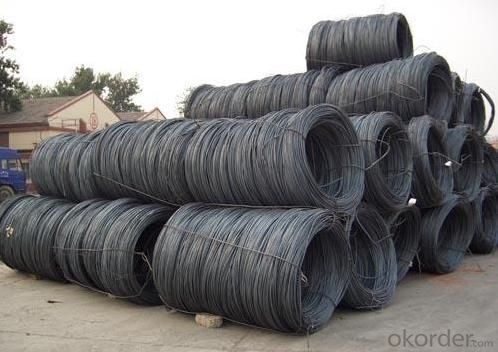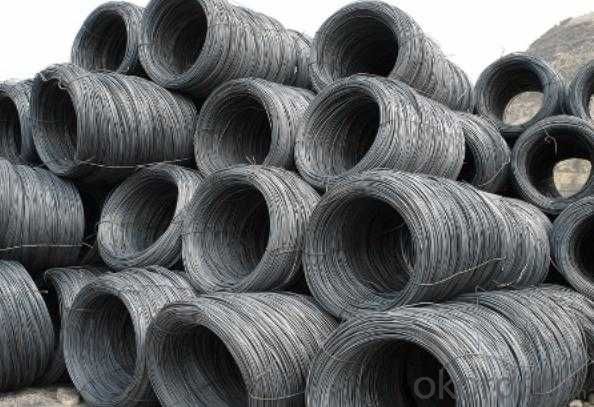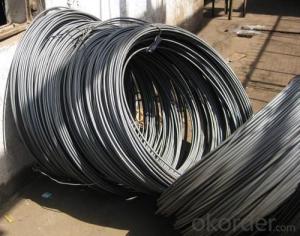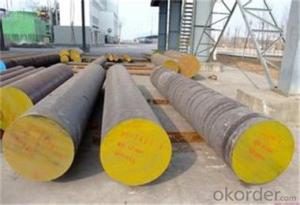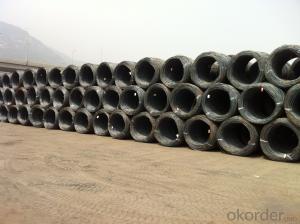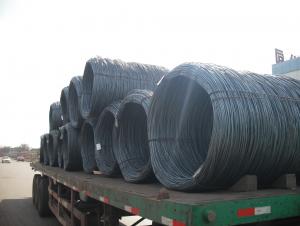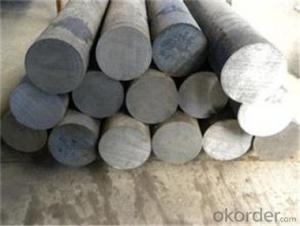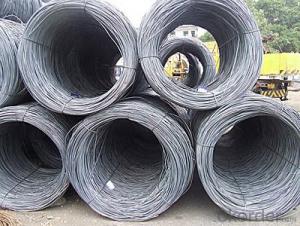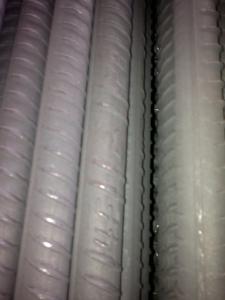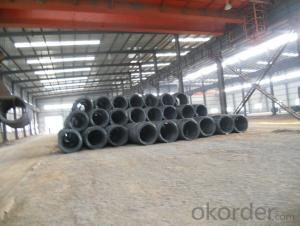Hot Rolled Steel Wire Rod with Good Quality with The Size 12mm
- Loading Port:
- Tianjin
- Payment Terms:
- TT OR LC
- Min Order Qty:
- 50 m.t.
- Supply Capability:
- 20000 m.t./month
OKorder Service Pledge
OKorder Financial Service
You Might Also Like
Hot Rolled Steel Wire Rod with Good Quality with The Size 12mm
Application: Carbon steel wire rod is widely used in construction and manufacturing. Carbon steel wire rod is mainly used for reinforcement of reinforced concrete and welded structure or reprocessed (roberts , nail, etc.) materials, especially used to produce wire drawing, welding electrode, nails, spring, electronic, precise machinery parts and so on.
Features:
Different Sizes: 5.5mm---16mm
Different Material Grade:SAE1006 SAE1008 SAE1010 SAE1012 etc
Packaging & Delivery of Wire Rod SAE1008B:
Packaging Detail: products are packed in coil and then shipped by container or bulk vessel
Each coil weight: 2-3MT
Delivery Detail: within 45 days after received deposit or LC.
Label: to be specified by customer, generally, each bundle has 1-2 labels
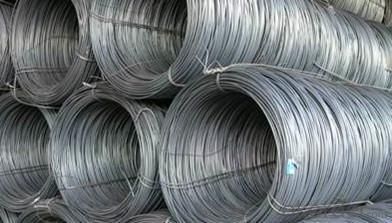
- Q: What are the common forming techniques used for steel wire rod?
- The common forming techniques used for steel wire rod include drawing, rolling, and extrusion.
- Q: How is steel wire rod used in the manufacturing of wire for automotive seat frames?
- The manufacturing process of wire for automotive seat frames relies heavily on steel wire rod. This essential material undergoes a series of steelmaking processes, including melting, refining, and casting, to form the wire rod. Afterward, the steel wire rod goes through further processing, such as hot rolling or cold drawing, to achieve the desired shape and size for the wire. Typically, in the production of wire for automotive seat frames, the steel wire rod is fed into a wire drawing machine. This machine pulls the wire rod through a series of dies, gradually reducing the wire's diameter while elongating it. This process enhances the wire's strength, flexibility, and surface finish. The resulting wire is then utilized to construct the seat frames of automobiles. With the help of specialized machinery and techniques, the wire is bent and shaped into the desired form. It is commonly used to create the seat's structural framework, providing it with the necessary strength and stability. The use of steel wire rod in the manufacturing of wire for automotive seat frames offers various advantages. Firstly, steel is a strong and durable material, ensuring that the seat frames can withstand the stresses and forces encountered during use. Additionally, steel wire is highly flexible, allowing for easy shaping and forming into intricate designs required for seat frames. Moreover, steel wire possesses excellent corrosion resistance properties, ensuring the seat frames remain in good condition for an extended period. Furthermore, steel wire rod is a cost-effective material choice for automotive seat frames. Steel is abundantly available and has relatively low production costs compared to other materials. This makes it an attractive option for manufacturers seeking to produce seat frames at a reasonable price without compromising quality or performance. In conclusion, steel wire rod plays a crucial role in the manufacturing of wire for automotive seat frames. Its strength, flexibility, corrosion resistance, and cost-effectiveness make it an ideal material choice. By utilizing steel wire rod, manufacturers can produce high-quality seat frames that meet the rigorous standards of the automotive industry.
- Q: How is steel wire rod used in the manufacturing of wire forms for automotive seat belts?
- Steel wire rod is used in the manufacturing of wire forms for automotive seat belts as it serves as the primary raw material. The steel wire rod is first drawn into a thinner wire and then formed into various shapes and sizes to create the necessary components of the seat belts, such as buckles, connectors, and retractors. This high-strength material ensures the seat belts can withstand the necessary forces and provide the required safety for passengers in vehicles.
- Q: What are the safety precautions to be taken while working with steel wire rod?
- When working with steel wire rods, it is important to follow certain safety precautions to ensure a safe working environment. Some of the precautions include wearing appropriate personal protective equipment (PPE) such as gloves, safety glasses, and steel-toed boots to protect against potential injuries. Additionally, workers should be trained on proper handling techniques, ensuring they are familiar with the weight and dimensions of the wire rods to prevent strain or accidents. It is crucial to use the right tools and equipment for cutting, bending, or manipulating the wire rods to minimize the risk of injury. Regular inspections of the wire rods for any defects or damages are also necessary to prevent accidents. Lastly, maintaining a clean and organized workspace, removing tripping hazards, and implementing proper storage procedures for the wire rods are essential to prevent accidents and injuries.
- Q: What are the standard ductility requirements for steel wire rod?
- The standard ductility requirements for steel wire rod are typically defined by specific industry standards and specifications. These requirements may vary depending on the intended application of the wire rod. In general, ductility refers to the ability of a material to deform under tensile stress without fracturing. For steel wire rod, a certain level of ductility is essential as it allows the wire to be easily formed, bent, or stretched without breaking. The specific ductility requirements for steel wire rod are typically expressed in terms of the elongation percentage, which is determined by conducting tension tests on the material. Elongation percentage is calculated by measuring the increase in length of the wire rod after it breaks during the tension test. Common industry standards, such as those set by the American Society for Testing and Materials (ASTM), typically specify minimum elongation requirements for different grades of steel wire rod. These requirements may vary depending on factors such as the wire rod diameter, manufacturing process, and intended application. For example, ASTM A510/A510M-18a, which covers general requirements for carbon and alloy steel wire rods and coarse round wire, specifies minimum elongation values ranging from 10% to 30% depending on the wire rod diameter. Other standards, such as those set by the International Organization for Standardization (ISO) or national standards bodies, may have similar or slightly different requirements. It is important to note that specific applications may have additional requirements beyond standard ductility specifications. For instance, certain industries may require enhanced ductility to meet specific performance criteria or to ensure the wire rod can withstand severe deformation without rupturing. Overall, the standard ductility requirements for steel wire rod are determined by industry standards and specifications, which typically define minimum elongation values. These requirements ensure that the wire rod possesses the necessary deformability to meet its intended application and manufacturing processes.
- Q: How are steel wire rods used in the manufacturing of wire brushes?
- Wire brushes rely on steel wire rods as a vital ingredient in their production. These rods act as the foundation for the brush's bristles. The first step involves drawing the steel wire rods through a series of dies to decrease their diameter and increase their length. This process, known as wire drawing, ensures that the wire attains the desired thickness and strength necessary for the brush's bristles. Once the wire has been drawn, it is then cut into specific lengths based on the brush's size. These cut lengths are then inserted into the brush's base, typically made of wood or plastic, and secured in place using various techniques like stapling or twisting. The steel wire rods utilized in wire brushes are generally crafted from high-quality carbon steel, which offers the necessary durability and flexibility for efficient brushing. Furthermore, the wire is frequently coated with a layer of protective material, such as zinc or brass, to prevent corrosion and enhance its lifespan. The bristles made from steel wire rods find extensive usage in a variety of industries and applications. Wire brushes with steel bristles are commonly employed for cleaning, deburring, polishing, and surface preparation tasks. They excel in removing rust, paint, and other stubborn residues from metal surfaces. The strength and resilience of steel wire bristles make them suitable for heavy-duty cleaning and abrasive tasks. To summarize, steel wire rods are essential in the production of wire brushes as they serve as the raw material for the bristles. Through processes like wire drawing, cutting, and securing, these rods are transformed into durable and efficient bristles that are widely utilized in multiple industries for cleaning and surface preparation purposes.
- Q: How is steel wire rod used in the production of tire reinforcement materials?
- Steel wire rod is used in the production of tire reinforcement materials as it provides strength and durability to the tires. The wire rod is typically twisted or braided together to form steel cords, which are then embedded in the tire's rubber compound. These steel cords help to improve the tire's strength, stability, and resistance to punctures, ensuring a safer and more reliable performance on the road.
- Q: What are the different surface finishing techniques for steel wire rod?
- Steel wire rods can undergo various surface finishing techniques to improve their appearance, durability, and functionality. Some commonly used techniques include: 1. Galvanizing: A layer of zinc is applied to the steel wire rod to protect it from corrosion. Galvanizing is widely used in outdoor applications like fencing, construction, and automotive industries due to its excellent rust resistance. 2. Electroplating: A thin layer of metal, like nickel or chrome, is electrochemically deposited on the surface of the steel wire rod. This technique enhances the rod's appearance and provides improved corrosion resistance. 3. Phosphating: The steel wire rod's surface is coated with a phosphate layer through a chemical process. This technique improves adhesion properties, corrosion resistance, and creates a suitable surface for subsequent coating or painting. 4. Pickling: Impurities and scale are removed from the steel wire rod's surface using an acidic solution. Pickling improves surface cleanliness and prepares the rod for further coating or painting. 5. Powder coating: A dry powder is applied to the surface of the steel wire rod and heated to form a protective and decorative coating. Powder coating provides excellent resistance to corrosion, impact, and UV rays, making it suitable for various applications like furniture, appliances, and automotive parts. 6. Passivation: A chemical process creates a protective oxide layer on the steel wire rod's surface to enhance corrosion resistance. This technique is commonly used for stainless steel wire rods to prevent rust and maintain appearance. 7. Anodizing: Although typically used for aluminum wire rods, anodizing can also be applied to steel wire rods. It involves controlled oxidation to form a durable and corrosion-resistant layer. Anodizing offers various decorative finishes and is commonly used in construction, aerospace, and automotive industries. These surface finishing techniques provide a wide range of benefits and can be chosen based on specific requirements like aesthetics, corrosion resistance, and durability for the steel wire rod's application.
- Q: How is steel wire rod used in the manufacturing of wire forms for elevator cables?
- Steel wire rod is a crucial component in the manufacturing of wire forms for elevator cables. The steel wire rod is first processed and drawn into a specific diameter and shape to meet the required strength and flexibility needed for elevator cables. The wire rod is then heated and coated with a protective layer to enhance its durability and resistance against corrosion. Once the steel wire rod is prepared, it is further processed to form wire strands. These wire strands are then twisted together to create elevator cables with the desired strength and load-bearing capacity. The number of wire strands and the tightness of the twisting are determined by the specific requirements of the elevator cable. The use of steel wire rod in the manufacturing of wire forms for elevator cables ensures the cables can withstand the heavy loads and continuous movement involved in elevator operation. The strength and flexibility of the steel wire rod contribute to the overall safety and reliability of the elevator cables. Additionally, the steel wire rod used in elevator cable manufacturing undergoes strict quality control measures to meet industry standards and regulations. This ensures that the wire forms produced using steel wire rod are of high quality, capable of withstanding the rigorous demands of elevator systems. In conclusion, steel wire rod plays a vital role in the manufacturing of wire forms for elevator cables. Its strength, flexibility, and durability are essential for creating elevator cables that can safely and reliably transport passengers and goods within buildings.
- Q: How is steel wire rod used in the manufacturing of wire forms for pet enclosures?
- Steel wire rod is an essential component in the manufacturing of wire forms for pet enclosures. This type of rod is typically made from high carbon steel, which provides excellent strength and durability. To create wire forms for pet enclosures, the steel wire rod is first processed through a series of machines that stretch and shape it into the desired wire thickness and length. This process, known as drawing, ensures that the wire is uniform and free from defects. Once the wire is ready, it is then bent and formed into various shapes and sizes to create the wire forms for pet enclosures. These wire forms can include panels, gates, and frames that are used to construct the enclosure. The use of steel wire rod in the manufacturing of wire forms for pet enclosures offers several benefits. Firstly, steel is a highly durable material that can withstand the wear and tear associated with pet activities. It is also resistant to rust and corrosion, ensuring that the wire forms remain in good condition even when exposed to various weather conditions. Additionally, steel wire rod provides the necessary strength and stability required to secure pets within the enclosures. This is crucial for ensuring the safety and security of the animals. The rigidity of the steel wire prevents pets from breaking or bending the wire forms, keeping them contained and protected. Furthermore, the versatility of steel wire rod allows for customization and flexibility in the design of wire forms. Manufacturers can create wire forms in different shapes, sizes, and configurations to cater to the specific needs of pet owners and their pets. In conclusion, steel wire rod plays a vital role in the manufacturing of wire forms for pet enclosures. Its strength, durability, and versatility make it an ideal material for creating secure and long-lasting enclosures for pets.
Send your message to us
Hot Rolled Steel Wire Rod with Good Quality with The Size 12mm
- Loading Port:
- Tianjin
- Payment Terms:
- TT OR LC
- Min Order Qty:
- 50 m.t.
- Supply Capability:
- 20000 m.t./month
OKorder Service Pledge
OKorder Financial Service
Similar products
Hot products
Hot Searches
Related keywords
